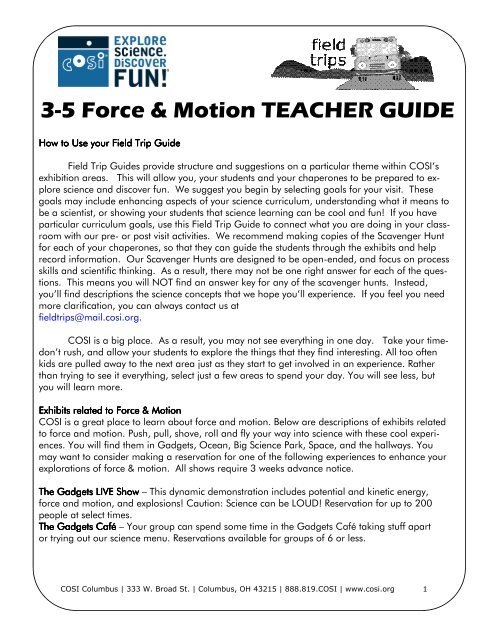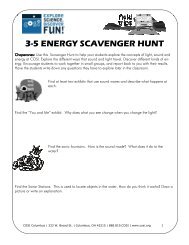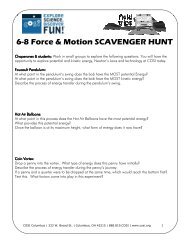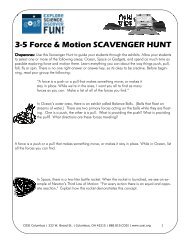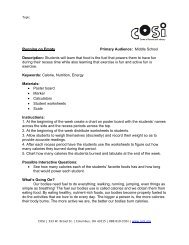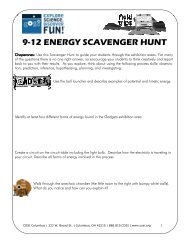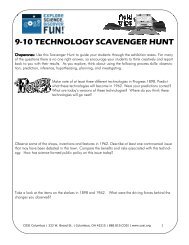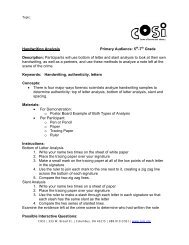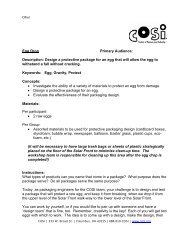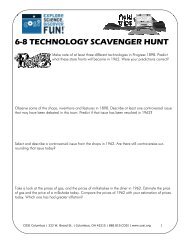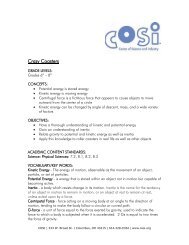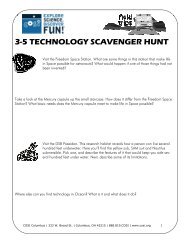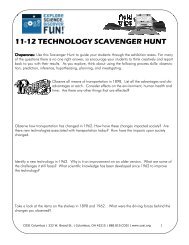3-5 Force & Motion TEACHER GUIDE - COSI
3-5 Force & Motion TEACHER GUIDE - COSI
3-5 Force & Motion TEACHER GUIDE - COSI
You also want an ePaper? Increase the reach of your titles
YUMPU automatically turns print PDFs into web optimized ePapers that Google loves.
3-5 <strong>Force</strong> & <strong>Motion</strong> <strong>TEACHER</strong> <strong>GUIDE</strong>How to Use your Field Trip GuideField Trip Guides provide structure and suggestions on a particular theme within <strong>COSI</strong>’sexhibition areas. This will allow you, your students and your chaperones to be prepared to explorescience and discover fun. We suggest you begin by selecting goals for your visit. Thesegoals may include enhancing aspects of your science curriculum, understanding what it means tobe a scientist, or showing your students that science learning can be cool and fun! If you haveparticular curriculum goals, use this Field Trip Guide to connect what you are doing in your classroomwith our pre- or post visit activities. We recommend making copies of the Scavenger Huntfor each of your chaperones, so that they can guide the students through the exhibits and helprecord information. Our Scavenger Hunts are designed to be open-ended, and focus on processskills and scientific thinking. As a result, there may not be one right answer for each of the questions.This means you will NOT find an answer key for any of the scavenger hunts. Instead,you’ll find descriptions the science concepts that we hope you’ll experience. If you feel you needmore clarification, you can always contact us atfieldtrips@mail.cosi.org.<strong>COSI</strong> is a big place. As a result, you may not see everything in one day. Take your timedon’trush, and allow your students to explore the things that they find interesting. All too oftenkids are pulled away to the next area just as they start to get involved in an experience. Ratherthan trying to see it everything, select just a few areas to spend your day. You will see less, butyou will learn more.Exhibits related to <strong>Force</strong> & <strong>Motion</strong><strong>COSI</strong> is a great place to learn about force and motion. Below are descriptions of exhibits relatedto force and motion. Push, pull, shove, roll and fly your way into science with these cool experiences.You will find them in Gadgets, Ocean, Big Science Park, Space, and the hallways. Youmay want to consider making a reservation for one of the following experiences to enhance yourexplorations of force & motion. All shows require 3 weeks advance notice.The Gadgets LIVE Show – This dynamic demonstration includes potential and kinetic energy,force and motion, and explosions! Caution: Science can be LOUD! Reservation for up to 200people at select times.The Gadgets Café – Your group can spend some time in the Gadgets Café taking stuff apartor trying out our science menu. Reservations available for groups of 6 or less.<strong>COSI</strong> Columbus | 333 W. Broad St. | Columbus, OH 43215 | 888.819.<strong>COSI</strong> | www.cosi.org 1
3-5 <strong>Force</strong> & <strong>Motion</strong> <strong>TEACHER</strong> <strong>GUIDE</strong>OCEANPoseidon's realm takes two forms in this unique learning environment. On one side of theexhibition, Poseidon reigns majestic over a mythical playground, symbolizing the ancient meansfor understanding the sea. Here, you can explore the physical nature of water through laminarstreams, eroding sand, and other activities, and at the same time being totally immersed in a theatricalrecreation of the ocean's power. On the other side of Ocean, Poseidon is the namesake ofan undersea research habitat, revealing the modern means for understanding the sea. Based onreal ocean exploration technology, the "D.S.B. Poseidon" uses submersibles sonar to explore thescientific side of Ocean.Caution: It is likely that your students will get wet. Encourage them to take care not to get otherswet in the process. Exhibits include:• The Cartesian Diver Divers will sink when their density is greater than the water surroundingthem. This is accomplished with a buoyancy compensator (BC) that they wear. As the air is removed,the BC will deflate. This decreases the divers overall volume, making him/her moredense than the surrounding water. Can you get <strong>COSI</strong>’s diver to go up and down? How aboutremain neutrally buoyant (the middle)?• Erosion Table As water is pulled by gravity to lower levels, it exerts a force of change upon thesurface on which it travels. This force of change is called erosion. The erosion table demonstratesfluvial (water) erosion on landmass. Where does the sand go? Where is sand washedaway faster? Slower? Why? Are there any areas that have no sand? Where? How would youexplain this observation? What ideas do you have to stop the flow of water? What do youthink will happen when the water is blocked? (Make and share predictions.) Have studentsconstruct a dam with the sand and compare their predictions with their observations about thedam.• Ball Fountains You will notice that the ball is spinning. The moving water sticks to the bottomof the ball and then is thrown from the top of the ball. The thrown water moves in one direction,causing the ball to move in the other direction. This is an example of Newton’s Third Lawof <strong>Motion</strong>: For every action, there is an equal and opposite reaction.• Laminar Flow The water coming out of the water cannons is an example of laminar flow. Noticethat this water is much less turbulent than the water in your kitchen sink. Does if feel orlook different than other streams of water you have seen? How is it different?• Water Jets Notice water popping up from the floor. Pumps push the water up and gravity pullsit back down. What else doe you notice? Does the water spray out or stick together? Whatmakes it do that?<strong>COSI</strong> Columbus | 333 W. Broad St. | Columbus, OH 43215 | 888.819.<strong>COSI</strong> | www.cosi.org 3
3-5 <strong>Force</strong> & <strong>Motion</strong> <strong>TEACHER</strong> <strong>GUIDE</strong>GADGETSAdmired for their ability to change how we do things, gadgets are tangible proof of how creativityadvances technology. The Gadgets exhibition area contains a variety of exhibits that allow gueststo explore the building blocks of more complex gadgets: pulleys, gears, lasers, and electric circuits.Guests can examine the inner workings of everyday gadgets by taking them apart in theGadgets Café. The café is an inventor's paradise that offers the tools necessary to investigate thegadgets we use daily. <strong>Force</strong> and motion exhibits include:• Pulley Chairs - An example of a simple machine that makes life easier. Each chair has adifferent number of pulleys, so you can try them all and feel the difference. If there are morepulleys, you expend less effort.• Air Cannon - Have some fun with the Air Cannon in the back of Gadgets. Toss a ball inand turn the handle to launch. Air from the compressor will push the ball. Try two or five orten balls. What happens?• Flying Propellers - Control the speed of the flying propellers, causing them to rise, fall, orhover on a pole that reaches the ceiling. The faster the propeller spins, the more air itpushes down, causing lift.• Newton’s Nozzles - Balance a ball inside a path of airflow. Air is pushing up on a ball.Since the ball is curved, the air travels over top of the ball. This action holds the ball inplace. This is an excellent demonstration of Newton’s third law: for every action there is anequal and opposite reaction.<strong>COSI</strong> Columbus | 333 W. Broad St. | Columbus, OH 43215 | 888.819.<strong>COSI</strong> | www.cosi.org 4
3-5 <strong>Force</strong> & <strong>Motion</strong> <strong>TEACHER</strong> <strong>GUIDE</strong>SPACEHow big is the universe? What drives humanity to the stars? These are questions that havepiqued the curiosity of many, and whose answers change as we gain more information about theuniverse. Space offers opportunities to think about these questions while at the same time relivesome of history's great space explorations. Enter the exhibit through the Black Hole, a cool spinningsensory experience, or sit in the Living Room and watch the history of space travel. Pleaseask students to use caution in the tunnel.• Overhead Thrusters Listen for the hissing sound. This is the sound of air being pushed throughthe thruster’s nozzles, causing thrust. Thrust is the primary means of acceleration in space. Inspace, propellant is pushed through a nozzle instead of air. Thrust from the air being forcedthrough the nozzles causes the thruster to move. The thruster has inertia. Inertia refers to anobject’s tendency to keep moving or the resistance to changes in motion. Until an outsideforce (air resistance, friction, collision) acts upon the thruster, it will continue to move. Thesethrusters will eventually stop on their own due to drag. The primary forces are air resistance(drag) and friction. In space, however, there is little gas, which means, little drag. To stop athruster here or in space, apply thrust in opposite direction. How do Newton’s laws of motionrelate to this exhibit? Newton’s first law of motion (objects in motion tend to stay in motion)explains why the thruster continues to fly after the thrust is disengaged. The thruster will continueto fly until some force opposes that motion. Newton’s second law (force = mass * acceleration)dictates the rate at which the thruster will accelerate when a force is applied eitherfrom thrust or air friction. Newton’s third law (every action has an equal and opposite reaction)is demonstrated by the simultaneous push the thruster exerts on the fuel (air) and pushthe fuel exerts on the thruster.• The Rocket Launch exhibit invites guests to "fuel up" a rocket by charging a projectile withcompressed air. Guests then perform their own countdown and release the miniature rocket,watching it arc 25 feet up to the ceiling. Rockets go because of Newton’s Third Law: For everyaction there is an equal and opposite reaction. Spent fuel escapes the rocket through a holecalled the nozzle. This is the action. The rocket moves away from the spent fuel, in effect pushingagainst it. This is the reaction. The more spent fuel the rocket leaves behind, and the fasterthe spent fuel moves, the faster the rocket will fly. Notice that the rocket does not push againstthe launch pad, the air, or anything else except its own fuel. This is the reason rockets canwork in outer space.<strong>COSI</strong> Columbus | 333 W. Broad St. | Columbus, OH 43215 | 888.819.<strong>COSI</strong> | www.cosi.org 5
3-5 <strong>Force</strong> & <strong>Motion</strong> <strong>TEACHER</strong> <strong>GUIDE</strong>Vocabulary WordsThese are some <strong>Force</strong> & <strong>Motion</strong> terms that you should be familiar with as you explore <strong>COSI</strong> withyour students:• <strong>Force</strong>: A push or pull on an object. You can observe a force when something flies, falls, spins,drops, rolls or stops.• Gravity: The earth’s pull on things.• Mass: A measure of quantity of matter in an object.• Newton’s First Law of <strong>Motion</strong>- An object in motion will stay in motion unless acted upon by anoutside force, or things will keep on doing what they are doing until something stops them.This is also known as inertia.• Newton’s Second Law of <strong>Motion</strong>: <strong>Force</strong> =Mass x acceleration, which translates to this: themore mass an object has, the more you have to push it. The harder you push an object, thefarther it will go.• Newton’s Third Law of <strong>Motion</strong>: When you push on an object, it pushes back, and is often referredto as action and reaction. This is not the same as cause & effect.• Speed: how far something goes in a certain amount of time.• Velocity: How fast and in what direction something is going.• Weight: The amount of gravitational pull on an object.Process Skills are the actions that it takes to “do science.” These are some of the scientific processskills that your students will be using as they explore the exhibits at <strong>COSI</strong>.• Observe - Use your senses to gather information.• Measure- Use tools and numbers to quantify objects or phenomena.• Categorize - Place objects into groups based on similarities or differences.• Communicate - Use words, pictures, graphs and diagrams to share your ideas.• Investigate - Follow a scientific method to formulate questions, conduct an experiment.• Apply - Put the information you’ve gathered to use.• Infer – Make an assumption based on your observations.• Question – Wonder and ask about things and find ways to discover answers.• Predict - Decide what will happen in the future based on your observations.<strong>COSI</strong> Columbus | 333 W. Broad St. | Columbus, OH 43215 | 888.819.<strong>COSI</strong> | www.cosi.org 6
3-5 <strong>Force</strong> & <strong>Motion</strong> <strong>TEACHER</strong> <strong>GUIDE</strong>StandardsGrade 3 Physical Science1. Describe an objects position by locating it relative to another object or the background.2. Describe an object’s motion by tracing and measuring its position over time.3. Identify contact-non-contact forces that affect motion of an object (e.g) gravity,magnetism & collision.)4. Predict the changes when an object experiences a force (e.g. push or pull, weight,friction.)Grade 3 Scientific Inquiry1. Select the appropriate tools and use relevant safety procedures to measure and recordlength and weight in metric and English units.6. Communicate scientific finds through a variety of methods (e.g. pictures, written, oraland recorded observations.)Grade 3 Science & Technology4. Use a simple design process to solve a problem (e.g. identify a problem, identifypossible solutions and design a solution.)5. Describe possible solutions to a design problem (e.g. how to hold a paper down in thewind.)Resourceshttp://www.kidsolr.com/science/index.htmlLots of excellent science links for kids.www.howstuffworks.com - Just about everything you’ve ever wanted to know is described at thisinformative and understandable website.www.physics4kids.com This website, although void of activities, has clear and accessible definitionsof a variety of physics terminology such as energy, forces, and friction.www.exploratorium.edu/snacks/iconmagnetism.html Some cool activities from the Exploratoriumrelated to magnetism.www.sciencenetlinks.com/lessons.cfm?BenchmarkID=4&DocID=405A lesson on gravity and other forces related to the launch of an object.www.mos.org/sln/Leonardo/InventorsToolbox.htmlDescription of simple machines<strong>COSI</strong> Columbus | 333 W. Broad St. | Columbus, OH 43215 | 888.819.<strong>COSI</strong> | www.cosi.org 7
3-5 <strong>Force</strong> & <strong>Motion</strong> <strong>TEACHER</strong> <strong>GUIDE</strong>Classroom ConnectionsYour visit to <strong>COSI</strong> should not a one day event, soon to be forgotten. Help your studentsmake connections between the classroom lessons and your field trip by doing activities related toyour visit. Before your visit, review the vocabulary words that the students will encounter, andbrainstorm things they already know about technology or <strong>COSI</strong> in general. Give them descriptionsof each of the areas and some of your expectations. If possible, review with the chaperones,so they know what to expect. After your visit, have your students draw pictures or write letters ofstories about their experience, and list questions they still have that you could explore together.Below are some lessons that you can use as pre-visit or post-visit activities to help connectyour field trip to your classroom experiences and extend your students’ learning. Consider doingone activity every day for a week before your visit.Newton’s in the Driver’s SeatObjective: To understand Newton’s Laws of <strong>Motion</strong>.Materials: 2 identical plastic toy cars, yardstick, science journal.<strong>COSI</strong> Connections: Rockets & Thrusters in Space, Ball Launcher in Gadgets,Centripetal Generotor in Big Science ParkProcedure:1. Place the two cars about 60 centimeters apart on a smooth flat surface.2. Count down, then gently push the cars toward each other.3. Note the point in which the cars make contact, and mark this spot, and write down anyother observations you have made.4. Measure the distance that each car travels and write this down.5. Do at least three more trials, and record your findings.6. Next, vary the experiment by changing the distance, speed, or amount of weight on thecars. Remember to change only one variable at a time.7. What happens when the cars made contact? Did changing variable produce the results youexpected?<strong>COSI</strong> Columbus | 333 W. Broad St. | Columbus, OH 43215 | 888.819.<strong>COSI</strong> | www.cosi.org 8
3-5 <strong>Force</strong> & <strong>Motion</strong> <strong>TEACHER</strong> <strong>GUIDE</strong>An Object in <strong>Motion</strong>Objective: Demonstrate that an object continues to move due to inertia.Materials: balloons, tape, straws, string<strong>COSI</strong> Exhibit Connections: Rockets and thrusters in Space, Rocket in Gadgets Live ShowProcedure:1. Cut a length of string 10 feet long and run the end of it through a plastic drinking straw.2. Give each group of students a balloon and some tape.3. Inflate the balloon (make sure only one person from the group does this) pinch it closed,and tape it to the straw. What happens when you release it? What is the action and what isthe reaction? What can you change or add to make it go faster? Slower? Farther?Paper Airplane ContestObjective: Design the best paper airplane or helicopterMaterials: Sheets of paper, scissors, tapeProcedure:1. Challenge students to design an airplane or helicopter that will fly the farthest or spend themost time in the air.2. Test out your planes, make changes to your designs and test again. What works best?3. Explain one change you made that had the biggest impact.In the NewsObjective: Understand a law of motion through writing.Materials: Paper & pencilProcedure:1. Early scientists like Sir Isaac Newton, Albert Einstein and Galileo, made some fundamentaldiscoveries of physical science. The fables tell us Newton noticed gravity when an apple fellfrom a tree. Pretend you are a reporter living along side one of these great scientists. Selectone of their discoveries. Do some research on what it is, and write a story or newspaperarticle about the discovery of it. In your article, talk about how the scientist first made thisdiscovery, what was done to prove it was true, and why it made him or her famous.2. An alternate assignment is to pretend that YOU made the discovery, and write the articleabout how you found out that your force exists. You can even name it after yourself.<strong>COSI</strong> Columbus | 333 W. Broad St. | Columbus, OH 43215 | 888.819.<strong>COSI</strong> | www.cosi.org 9


